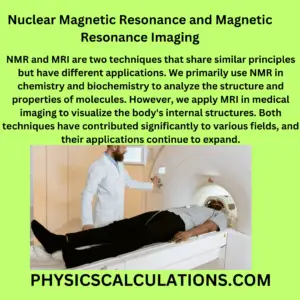Introduction
Magnetic resonance imaging (MRI) and nuclear magnetic resonance (NMR) are two scientific techniques that have revolutionized the fields of medicine and chemistry, respectively. Although they are similar in some ways, they have significant differences that set them apart. This article will explore the principles and applications of NMR and MRI, their similarities, differences, and how they have contributed to various fields.

Principles of Nuclear Magnetic Resonance
Nuclear magnetic resonance is a phenomenon that occurs when the nuclei of atoms with an odd number of protons and/or neutrons are placed in a magnetic field. When subjected to a magnetic field, the nucleus aligns itself with the field. Thus, if we apply radiofrequency pulse at a particular frequency, the nucleus will absorb the energy and resonate. This resonance is detected and analyzed to yield information about the local chemical environment of the nucleus.
Spin and Magnetic Moment
Nuclei with an odd number of protons and/or neutrons have a property called spin, which causes them to behave like tiny magnets. The magnetic moment of a nucleus is proportional to its spin and is used to describe the strength and orientation of the magnetic field that the nucleus produces.
Nuclear Magnetic Resonance and Energy
When a nucleus is placed in a magnetic field, it can be in one of two energy states. This depends on its orientation relative to the field. When we apply a radiofrequency pulse, there will be an absorption of the energy difference between the two states. Thus, the nucleus transites from the lower to the higher energy state. Therefore, this helps us to adjust the frequency of the radiofrequency pulse to match the energy difference between the two states.
Applications of Nuclear Magnetic Resonance
Nuclear magnetic resonance has a wide range of applications, including spectroscopy and imaging.
Spectroscopy
NMR spectroscopy is for determining the chemical structure of molecules. When we plae a molecule in a magnetic field, the nuclei in different parts of the molecule resonate at different frequencies. This depends on their local environment. We can obtain the information about the chemical structure of the molecule by analyzing the frequencies of the resonances.
Imaging
Nuclear magnetic resonance imaging, also known as magnetic resonance imaging (MRI), is a non-invasive imaging technique that uses a magnetic field and radio waves to generate images of the inside of the body. We can use MRI to take image of soft tissues. This tissues include the brain, spinal cord, and muscles. Unlike X-rays and CT scans, MRI does not use ionizing radiation, which makes it safer for the patient.
Magnetic Resonance Imaging: Principles and Applications
Magnetic resonance imaging works by using a strong magnetic field to align the protons in the body. Subsequently, we can now apply a radiofrequency pulse to the body, which causes the protons to absorb energy and resonate. We can detect resonance signals with a computer and use them to build images of the body.
Clinical Applications of MRI
With MRI, we can diagnose and monitor a variety of medical conditions. These medical conditions include neurological disorders, musculoskeletal injuries, and cancer. Additionally, we can also use it in research to study the structure and function of the brain.
Comparison between NMR and MRI
We primarily use NMR in the field of chemistry and biochemistry to analyze the structure and properties of molecules. For MRI, we use it in medical imaging to visualize the body’s internal structures. Furthermore, NMR typically involves analyzing a sample in a laboratory setting. On the other side, MRI is important in taking images of living organisms in real-time. The equipment used for NMR and MRI is also different, with NMR machines being smaller and less powerful than MRI machines.
Future Directions
NMR and MRI have already revolutionized the fields of chemistry and medicine, and their applications continue to expand. New advances in technology, such as hyperpolarization and portable MRI machines, are making NMR and MRI more powerful and accessible than ever before.
Conclusion
In conclusion, NMR and MRI are two techniques that share similar principles but have different applications. We primarily use NMR in chemistry and biochemistry to analyze the structure and properties of molecules. However, we apply MRI in medical imaging to visualize the body’s internal structures. Both techniques have contributed significantly to various fields, and their applications continue to expand.
Frequently Asked Questions (FAQs)
- Is MRI safe?
- Yes, MRI is generally considered safe. However, there are some risks associated with MRI, such as interference with pacemakers or other implanted devices. Patients with metal implants or other health conditions should consult with their doctors before undergoing an MRI.
- What is the difference between an MRI and a CT scan?
- CT scans use X-rays to generate images of the body, while MRI uses a magnetic field and radio waves. CT scans are generally faster than MRI and are better at detecting bone fractures and other abnormalities in the bones, while MRI is better at visualizing soft tissues, such as the brain and muscles.
- What is the difference between 1D, 2D, and 3D NMR?
- 1D NMR measures the resonance frequency of a single nucleus, while 2D NMR measures the interactions between different nuclei in a molecule. 3D NMR is a more advanced technique that can resolve complex molecular structures in three dimensions.
- Can MRI detect cancer?
- Yes, we can use MRI to detect and monitor cancer. MRI is particularly useful for detecting tumors in the brain, breast, and prostate.
- What is hyperpolarization?
- Hyperpolarization is a technique that increases the magnetic resonance signal of molecules, making them more detectable by NMR and MRI machines. Hyperpolarization has the potential to revolutionize NMR and MRI by making them more powerful and accessible.
You may also like to read:
What is the Relation Between Spin and Magnetic Moment